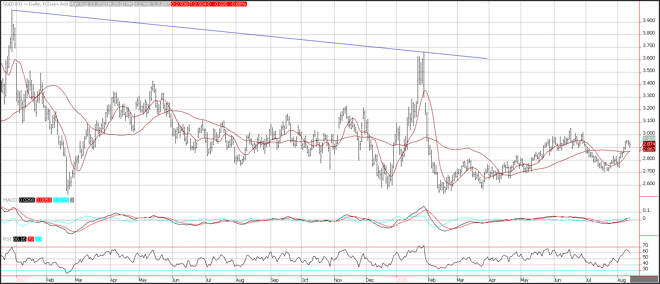Advertisement
Advertisement
Natural Gas Price Prediction – Prices Consolidate Following Last Weeks Breakout
By:
Natural gas prices continued to consolidate trading sideways for the second straight trading session after breaking through trend line resistance last
Natural gas prices continued to consolidate trading sideways for the second straight trading session after breaking through trend line resistance last week. The warmer weather pattern appears to be changing with a cool front making its way into the middle of the United States. The coasts will be warmer than normal but the cooling in the mid-west should offset the heavy cooling demand allow inventories to grow at normal rates.
Technicals
Prices continue to trade sideways above the 50-day moving average which is seen as support near 2.87. the 20-day moving average has crossed above the 50-day moving average which shows that a medium term up trend is now in place. Positive momentum is decelerating as the MACD (moving average convergence divergence) histogram has a declining trajectory which points to consolidation. The RSI is also turning over and pointing down which reflects decelerating positive momentum.
The EIA reported that working gas stocks are below the five-year range for the second week. The average rate of net injections into storage is 18% lower than the five-year average so far in the 2018 refill season. The EIA also states that for gas inventories to reach the five-year average rate of injections of 10.0 Bcf per day for the remainder of the refill season, they will need to total 3,243 Bcf on October 31, which is 317 Bcf lower than the five-year low of 3,560 Bcf.
The EIA reports that in the Lower 48 states, total working gas stocks are currently 16 Bcf and 58 Bcf lower than the five-year range in the East and Midwest regions, respectively. The South Central region posted working gas stocks that are 46 Bcf higher than the bottom of the five-year range, with the nonsalt facilities 46 Bcf higher than its lower bound. Total working gas stocks in the Lower 48 states are now 57 Bcf below the five-year range. The Price differences between the spot price and the futures prices at the Nymex indicate limited economic incentives for net injections into working gas.
About the Author
David Beckerauthor
David Becker focuses his attention on various consulting and portfolio management activities at Fortuity LLC, where he currently provides oversight for a multimillion-dollar portfolio consisting of commodities, debt, equities, real estate, and more.
Did you find this article useful?
Latest news and analysis
Advertisement
